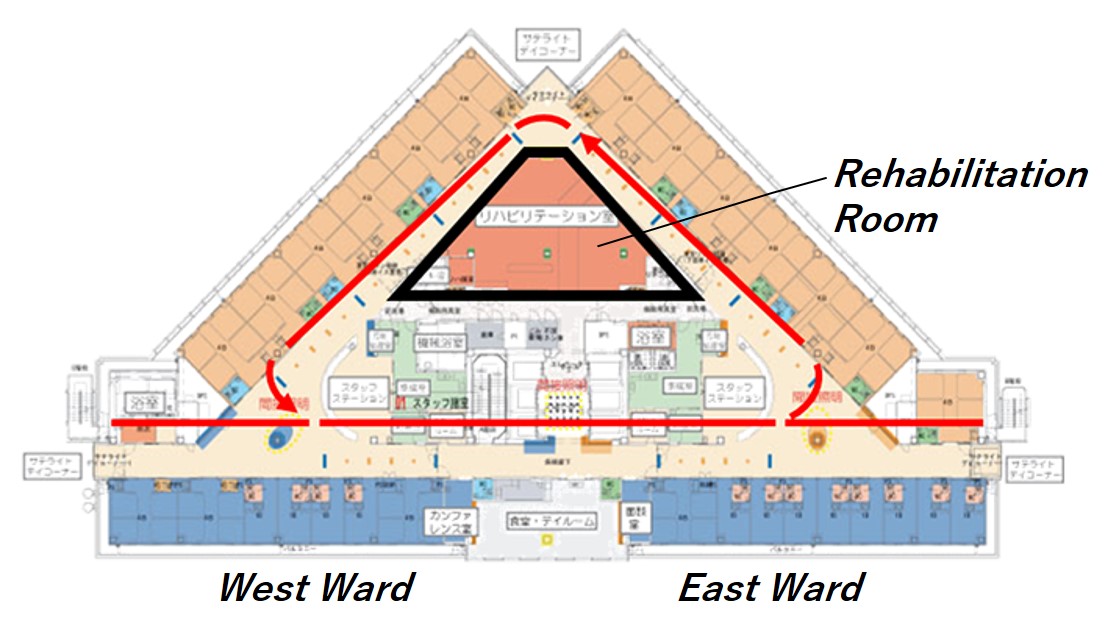About Morinomiya Hospital
Our Mission
-To be the most reliable hospital in the community, we provide specialized medical service with the highest quality and safety.
-To achieve highest functioning of the physically challenged people, we provide specialized rehabilitation & nursing care service with the highest quality and safety.
Our Policies
-We contribute to the regional establishment of community and emergency medicine.
-We provide optimized medical practice according to the evidence-based medicine.
-We nurture safety culture in the medical practice.
-We provide informed consent based on patients’ right and hope.
-We promote education and research to nurture specialists with heart and skill.
-We establish community-based integrated care system in collaboration with local health care resources.
Our Specific Medical Services
| Kaifukuki (convalescent) Rehabilitation | Cardiovascular Center | Peripheral Artery disease Clinic |
| Breast Cancer Center | Pediatric Rehabilitation | Dentist for the Physically challenged |
*Integrated Acute & Rehabilitation Ward enabling various aspects of our medical Services
-Enriched environment
-Enriched rehabilitation (3 hour session every 365 day)
Common Ward Structure

Research Activities
Selected Books
- Miyai I. Cortical networks associated with locomotion in man and patients with hemiparetic stroke. In Swinnen SP, Duysens J eds. Neurobehavioral determinants of interlimb coordination, Kluwer Academic Publishers, Norwell, MA, 2004, p.109-128. Kluwer Academic Publishers, Norwell, MA, 02061, ISBN 1-4020-7778-5, February 2004, 360 pp.
- Miyai I. Longitudinal optical imaging study for locomotor recovery after stroke. State-of-the-art-imaging in stroke. Vol. 2. Schaller B ed., Nova Science Publisher, New York, 2008, 41-74.
- Mihara M,Miyai I.
Applications of Near Infrared Spectroscopy in Neurorehabilitation.
Infrared Spectroscopy - Life and Biomedical Sciences. 41-56. InTech. 2012April. - Miyai I. Physical therapy and Rehabilitation in Patients with Degenerative Cerebellar Disease:Current Evidence and Future Direction. Neurodegenerative Disorders as Systemic Diseases. 217-235.Springer,Tokyo.2015.
Selected Articles
- Miyai I, Ito M, Hattori N, Mihara M, Hatakenaka M, Yagura H, Sobue G, and Nishizawa M. Cerebellar ataxia rehabilitation trial in degenerative cerebellar diseases. Neurorehabil Neural Repair. 2012;26(5):515-22.
- Mihara M, Hattori N, Hatakenaka M, Yagura H, Kawano T, Hino T, and Miyai I. Near-infrared spectroscopy-mediated neurofeedback enhances efficacy of motor imagery-based training in poststroke victims: a pilot study. Stroke. 2013;44(4):1091-8.
- Fujimoto H,Mihara M,Hattori N, Hatakenaka M, Kawano T, Yagura H, Miyai I, Mochizuki H. Cortical changes underlying balance recovery in patients with hemiplegic stroke. Neuroimage. 2014;85(1):547-554.
- Kawano T, Hattori N, Uno Y, Kitajo K, Hatakenaka M, Yagura H, Fujimoto H, Yoshioka T, Nagasako M, Otomune H, Miyai I. Large-Scale Phase Synchrony Reflects Clinical Status After Stroke: An EEG Study. Neurorehabilitation and Neural Repair. 2017;31(6) 561– 570.
- Mihara M, Fujimoto H, Hattori N, Otomune H, Kajiiyama Y, Konaka K, Watanabe Y, Hiramatsu Y, Sunada Y, Miyai I, Mochizuki H.
Effect of Neurofeedback Facilitation on Poststroke Gait and Balance Recovery: A Randomized Controlled Trial.
Neurology.2021;96(21):2587-2598. - Kawano T, Hattori N, Uno Y, Hatakenaka M, Yagura H, Fujimoto H, Nagasako M, Mochizuki H, Kitajo K, Miyai I.
Association between aphasia severity and brain network alterations after stroke assessed using the electroencephalographic phase synchrony index.
Scientific Reports. 2021;11:12469.
Map
2-1-88,Morinomiya ,Joto-ku,
Osaka,Osaka,Japan
〒536-0025
+81-6-6969-0111(Tel)
+81-6-6969-8001 (Fax)

